An aviator badge is an insignia used in most of the world's militaries to designate those who have received training and qualification in military aviation. Also known as a pilot's badge, or pilot wings, the aviator badge was first conceived to recognize the training that military aviators receive, as well as provide a means to outwardly differentiate between military pilots and the “foot soldiers” of the regular ground forces.
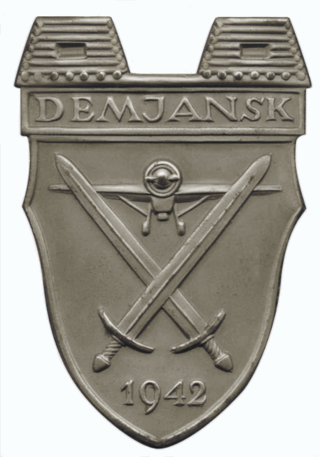
Demyansk Shield was a World War II German military decoration awarded to Wehrmacht personnel who fought in the Demyansk pocket on the Eastern Front in the early months of 1942. The pocket of German troops had been encircled and cut off by the Red Army around Demyansk (Demjansk), south of Leningrad, and was successfully defended with the aid of an airbridge. The shield was instituted on 25 April 1943 by Adolf Hitler and was not bestowed after 1 July 1944.

The Kuban Shield was a World War II military decoration of Nazi Germany. It was awarded to Wehrmacht forces who fought at the Kuban bridgehead in the Soviet Union from February 1943 until it was abandoned in October 1943. The award was instituted on 21 September 1943.

The Narvik Shield was a World War II German military decoration awarded to all German forces that took part in the battles of Narvik between 9 April and 8 June 1940. It was instituted on 19 August 1940 by Adolf Hitler. The Oberkommando der Wehrmacht (OKW) published the order the same day. It was bestowed by General Eduard Dietl, the commander of Army Group Narvik.

The Naval Artillery War Badge or War Badge for the Coastal Artillery was a World War II German military decoration awarded to the crews of Kriegsmarine land-based marine artillery and anti-aircraft units. It was presented to personnel of coastal defense units, and anti-aircraft units. The award was instituted on 24 June 1941 by Grand Admiral Erich Raeder to reward the actions of both individuals and crew members. It was also awarded to those killed in action in said units.

The U-boat War Badge was a German war badge that was awarded to U-boat crew members during World War I and World War II.

The U-boat Front Clasp or U-boat Combat Clasp, was a World War II German Kriegsmarine military decoration awarded to holders of the U-boat War Badge to recognize continued combat service and valor.

The Crimea Shield was a World War II German military decoration. It was awarded to military personnel under the command of Field Marshal von Manstein, including supporting naval and air force units, who fought against Soviet Red Army forces between 21 September 1941 and 4 July 1942 and who captured the Crimea region. It was instituted on 25 July 1942. It was the most widely distributed of the various German campaign shields, with approximately 250,000 awarded.

The Parachutist Badge was a badge awarded to qualified parachutists of the Wehrmacht and the Waffen-SS of Nazi Germany.

The Pilot/Observer Badge was a World War II German military decoration awarded to Luftwaffe service personnel who had already been awarded the Pilot's Badge and Observer Badge. It was instituted on 26 March 1936 by the Commander in Chief of the Luftwaffe Hermann Göring. It was worn on the lower part of the left breast pocket of the service tunic, underneath the Iron Cross 1st Class if awarded. It was to replace the older 1933 Aircrew Badge.
The Balloon Observer's Badge was a military decoration of Nazi Germany during World War II. It was awarded to German Army personnel who operated gas balloons flying them 300 ft (91 m)-500 ft (152 m) above the ground. The balloons were easy targets for Allied pilots and ground fire. Due to its late introduction, only a very small number of badges were awarded.
The Nazi Party Long Service Award, sometimes called the NSDAP Long Service Award, was a political award in the form of a badge of the Nazi Party.

The Army Anti-Aircraft Badge or Army Flak Badge was a German military decoration awarded to German Army personnel for service in an anti-aircraft battery during World War II. Designed by Wilhelm Ernst Peekhaus, it was of single piece construction. The pin back and clasp badge was grey metal in color. The badge was made in one grade; it had the national eagle at the top and an oak leaf wreath around the outside rim. In the middle was an 88 mm flak gun with the barrel facing upwards to the "viewer's" right.
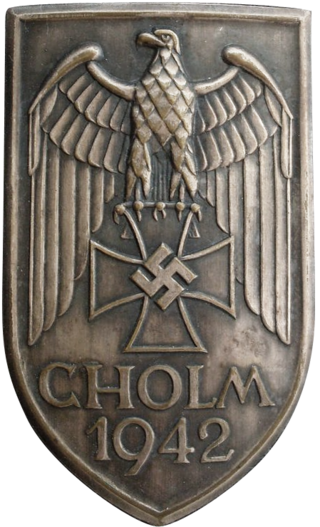
The Cholm Shield was a World War II German military decoration awarded to those who fought in the Cholm Pocket on the Eastern Front between 21 January and 5 May 1942. It was instituted on 1 July 1942 and is the rarest of the German combat shields, with approximately 5,500 recipients. Awards ceased to be bestowed on 1 April 1943.
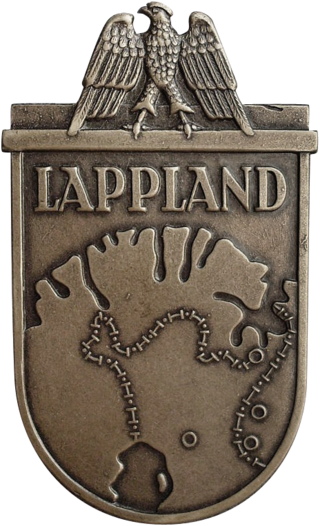
The Lapland Shield was a World War II German military decoration awarded to military personnel of General Franz Böhme’s 20th Mountain Army which fought a two-front campaign against advancing Finnish and Soviet Red Army forces in Lapland between November 1944 and the war’s end in May 1945. It was awarded to men who had "honorably served" for six months in the region or had been wounded during operations there. It was authorized in February 1945 and was the last officially instituted German campaign shield of the war.
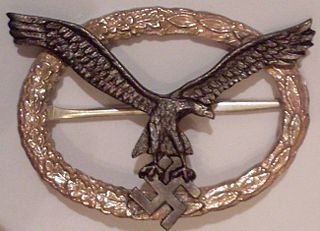
The Aircrew Badge was a German military decoration awarded to members of the German Air Sports Association, an organisation set up by the Nazi Party in March 1933 to establish a uniform basis for the training of military pilots. The German Air Sports Association was a cover organization for the future German Air Force (Luftwaffe). Its chairman was the future Commander in Chief of the Luftwaffe Hermann Göring and its vice-chairman Ernst Röhm. Since the Treaty of Versailles officially forbade Germany from building fighter planes of any sort, the German Air Sports Association used gliders to train men who were still officially civilians for the future Luftwaffe. It was the first qualification badge recognized by the Luftwaffe.

The Radio Operator & Air Gunner's Badge is a commonly accepted title for the Luftwaffen-Fliegerschützen-Bordfunker-und Bordmechanikerabzeichen. It was a German military decoration awarded to radio operators, air gunners and mechanics who were members of the German Air Force (Luftwaffe) after they completed two months training or had taken part in at least five operational flights. If wounded during an operational flight, the badge could be awarded and worn earlier. Later in June 1942, a separate badge was introduced for air gunners and flight engineers. That badge had the same qualifications.

The Air Gunner's and Flight Engineer's badge was a German military decoration awarded to air gunners, mechanics or aircrew meteorologists who were members of the German Air Force (Luftwaffe) after they completed two months training or had taken part in at least five operational flights. If one was wounded during an operational flight, the badge could be awarded earlier. For Luftwaffe members who were air gunners and mechanics this badge replaced an earlier separate badge which had been introduced back in 1935. The qualifications for the two badges were the same for recipients.
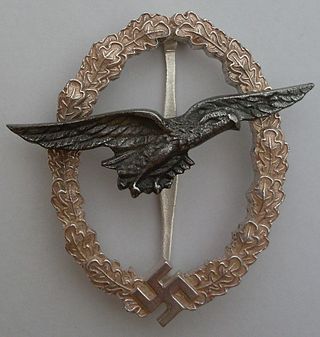
The Glider Pilot's Badge was a German military decoration that was awarded during World War II to military pilot's who were members of the German Air Force (Luftwaffe) after they completed their glider training. Honorably discharged personnel who met the requirements could also be awarded the badge. A citation was issued with the awarded badge. It was worn on or right below the left breast tunic pocket.

The Observer's Badge was a German military decoration that was awarded before and during World War II to members of the German Air Force (Luftwaffe). They qualified for the badge after completing two months of qualifying service and five operational flights in the role of observer, navigator or bombardier; also, it could be awarded after a member of the German Air Force was wounded while acting in the capacity of an observer during a qualifying flight. It was worn on the left breast tunic pocket of an air force or political uniform tunic. A citation was issued with the awarded badge. Thereafter, Luftwaffe service personnel who had already been awarded the Pilot's Badge and Observer's Badge could qualify for the Pilot/Observer Badge. After 31 July 1944 the regulations were changed and the recipient had to have held both qualification certificates for at least one year to qualify for the Pilot/Observer Badge.
















